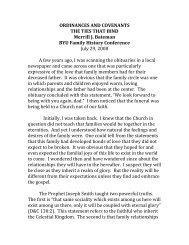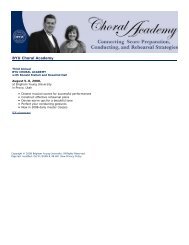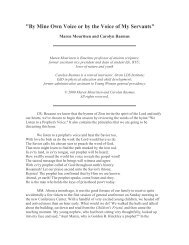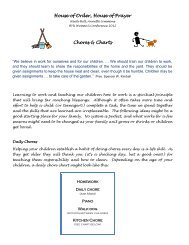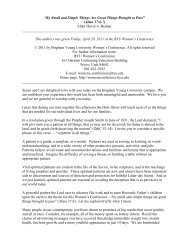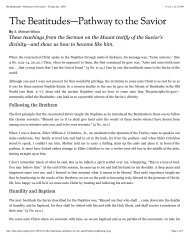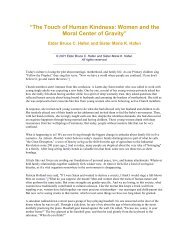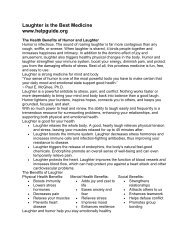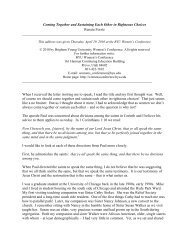Intimacy In Marriage - Continuing Education - Brigham Young ...
Intimacy In Marriage - Continuing Education - Brigham Young ...
Intimacy In Marriage - Continuing Education - Brigham Young ...
Create successful ePaper yourself
Turn your PDF publications into a flip-book with our unique Google optimized e-Paper software.
The Importance of <strong><strong>In</strong>timacy</strong> in <strong>Marriage</strong><br />
<strong><strong>In</strong>timacy</strong> in <strong>Marriage</strong><br />
Robert F. Stahmann<br />
This address was given at the BYU Families<br />
Under Fire Conference, October 4–5, 2004<br />
© 2004 by <strong>Brigham</strong> <strong>Young</strong> University<br />
Division of <strong>Continuing</strong> <strong>Education</strong><br />
All rights reserved.<br />
For further information write:<br />
BYU Families Under Fire<br />
136 Harman <strong>Continuing</strong> <strong>Education</strong> Building<br />
Provo, Utah 84602<br />
(801) 422-3559<br />
E-mail: conferences@byu.edu<br />
Home page: http://familiesunderfire.byu.edu<br />
For parents and children, husband and wife intimacy is crucial for strong family and marital<br />
relationships. An intimate relationship is one of caring, mutual trust, and acceptance. Caring is<br />
showing genuine concern for a person’s well-being. Mutual trust is the feeling that one person<br />
will not be harmed or hurt by another. Acceptance is the recognition or approval of each other.<br />
Relationships with these qualities set the foundation for healthy nonsexual and sexual intimacy<br />
in marriage.<br />
A loving and joyful marriage is one in which both partners are intimate with each other and are<br />
both nonsexually and sexually fulfilled and nurtured. An intimate sexual relationship is one of<br />
the most important aspects of marriage. It keeps marriage vital. It is the glue that holds couples<br />
together. Without it, small problems become large ones, and large problems can result in<br />
destroying the marriage.<br />
Regarding the importance and purposes of sexual intimacy, President Kimball stated, “The Bible<br />
celebrates sex and its proper use, presenting it as God-created, God-ordained, God-blessed. It<br />
makes it plain that God himself implanted the physical magnetism between the sexes for two<br />
reasons: for the propagation of the human race, and for the expression of the kind of love<br />
between man and wife that makes for true oneness. His command to the first man and woman to<br />
be ‘one flesh’ was as important as his command to ‘be fruitful and multiply.’”
Dr. David Mace, who is a longtime marriage counselor and writer, spent his career observing the<br />
dynamics of marriage. He pointed out “the sexual side of marriage is closely linked with the<br />
emotional and personal elements in the relationship. . . . What the married couple have to<br />
achieve, therefore, is a sexual relationship that expresses, sustains, and renews their deepest and<br />
most tender feelings for each other.”<br />
Forms or Dimensions of <strong><strong>In</strong>timacy</strong><br />
It is interesting to note that the forms or dimensions of intimacy listed below, except for the<br />
sexual dimension, are developed during dating and courtship. During dating and courtship, the<br />
couple develops patterns and behaviors that serve as a foundation for the marital relationship and<br />
intimacy in marriage. “The process of establishing marital intimacy is truly a process that begins<br />
before the wedding and continues after it, even for time and eternity.” (Stahmann, <strong>Young</strong>,<br />
Grover, 2004).<br />
Social. <strong>Marriage</strong> has a social dimension in which the partners enjoy doing things together and<br />
look forward to spending time together.<br />
Emotional. Here the couple is able to share personal feelings, to trust one another, and to feel<br />
safe and secure with each other.<br />
Cognitive/planning. <strong>Marriage</strong> has a cognitive and planning dimension, which includes sharing<br />
thoughts about life, making plans together, and discussing goals.<br />
Financial. The fiscal dimension of marriage deals with decisions and actions concerning earning<br />
a living, spending money, and managing temporal resources.<br />
Spiritual. <strong>Marriage</strong> has a spiritual and philosophical dimension that includes sharing spiritual<br />
and religious attitudes, behaviors, beliefs, and life experiences.<br />
<strong>In</strong>tergenerational. <strong>In</strong> marriage the couple is linked to their families of origin and two extended<br />
family relationships. The married couple is a branch on their family trees.<br />
Affectional. <strong>Marriage</strong> has an affectional dimension in which spouses nurture and support each<br />
other emotionally and physically, but not necessarily in sexual ways.<br />
Sexual. Husband and wife share their physical love for each other by sharing their bodies and<br />
physically becoming one.<br />
Five Areas for Couples to Discuss Together Regarding Sex<br />
It has been suggested that married couples ought to be able to discuss their sexual relationship.<br />
The following questions can guide that discussion.<br />
1. Is our sex education adequate?<br />
2. Are our individual attitudes about sex sound and healthy?
3. Can we discuss openly and together our sexual feelings and responses?<br />
4. Do we agree on our sexual experiences?<br />
5. When being sexual, do we put the emphasis on sex as a loving experience and not as<br />
performance?<br />
The (Different) Meaning of Physical Affection to Men and Women<br />
Both men and women share the basic need to be intimate with their husband or wife. However,<br />
what this means from both a sexual and emotional standpoint is somewhat different for men and<br />
women. Boys and girls are socialized and taught differently about affection and being<br />
affectionate. Therefore, typically men and women enter marriage with differing beliefs and<br />
expectations about giving and receiving affection. Having a basic understanding of such<br />
differences is important so that misunderstanding, frustrations, and anger can be avoided. The<br />
following generalizations are meant to provide general guidelines and ideas for the marital<br />
couple to discuss together.<br />
It’s been said that, typically, men give love and commitment in order to get physical affection<br />
and sex. Women give physical affection and sex in order to get commitment and love. It might<br />
also be said that men typically hunger for sex while women hunger for romance. Men initially<br />
give and receive love to fulfill their physical needs, while women initially give and receive love<br />
to fulfill their emotional needs.<br />
Often, women need to feel loved and nurtured before they begin to be aroused and develop<br />
desire for sexual intimacy. For women, emotional intimacy is at least as important as the act of<br />
sexual intercourse.<br />
Men often need to be sexually aroused before they can truly feel and express love. It’s through<br />
sexual activity that men are emotionally and physically fulfilled. Sexual activity often enables<br />
men to become aware of their wives’ need for love and emotional support.<br />
Unless partners understand such differences (and others) between men and women, it can be<br />
difficult or frustrating for them to find a common ground so that the emotional and physical<br />
desires and needs of both can be fulfilled. Understanding each other’s feelings and expectations<br />
regarding intimacy (in all its dimensions) and being intimate is the key. When couples<br />
understand their own expectations and feelings, as well as those of their spouse, 70 to 80 percent<br />
of the time that is all that is needed.<br />
<strong>In</strong> our culture, there are vast differences as to what young people learn about the anatomy and<br />
physiology of boys and girls, men and women, and about sexuality. Often young adults approach<br />
marriage with inadequate knowledge of their own or the other gender’s body. This can lead to<br />
misunderstandings or unnecessary anxiety. The LDS Church’s policy regarding sex education is<br />
that it is best taught and discussed in the home. To assist in this process, the Church has<br />
published A Parent’s Guide, which is helpful in understanding and in teaching sexual<br />
information.
President Spencer W. Kimball said, “The Bible makes plain that evil, when related to sex, means<br />
not the use of something inherently corrupt but the misuse of something pure and good. It<br />
teaches clearly that sex can be a wonderful servant but a terrible master: that it can be a creative<br />
force more powerful than any other in the fostering of love, companionship, and happiness, or<br />
can be the most destructive of all life’s forces.”<br />
For a useful resource overviewing the basic anatomy (structures) and physiology (how they<br />
function) of male and female anatomy, see the Web site:<br />
http://training.seer.cancer.gov/module_anatomy/unit12_1_repdt_intro.html.<br />
Some Thoughts on Protecting Sexual Health in <strong>Marriage</strong>:<br />
1. The greatest marriage killer is when husband and/or wife do not give adequate time and<br />
attention to their marriage. Nurture all aspects of your marriage.<br />
2. Have a “date night” once a week.<br />
3. Take time for romance. (Hint: Romance is more that being sexual. Remember how you<br />
were romantic during your courtship?)<br />
4. Learning to be sexual and being sexual are lifelong tasks of marriage. Learning together,<br />
with and from each other, is intimacy<br />
5. Remember that good sex and romance begin while your clothes are still on.<br />
6. Realize that good sex isn’t just a matter of pushing the “right” buttons.<br />
7. Don’t let sexual interaction become a routine matter.<br />
8. Don’t carry anger or criticism into the bedroom.<br />
9. Don’t make sex too serious. Have fun. Make it a time for renewal of intimacy.<br />
10. Keep your sexual (and other) expectations realistic.<br />
The LDS Church does have a “policy” on birth control, which is found in the Handbook of<br />
<strong>In</strong>structions for Bishoprics and Stake Presidencies. <strong>In</strong> the handbook it states that it is a privilege<br />
for couples to have children and that the couple is then responsible to nurture and rear them. The<br />
decision as to how many children to have and when to have them is personal and private and is<br />
for the couple to decide. This statement admonishes couples not to judge one another in such<br />
matters. It also points out that sexual relations in marriage are divinely approved and are both a<br />
means for procreation and also for expressing love and strengthening emotional and spiritual<br />
bonds between the husband and wife.<br />
Within the bonds of marriage, sexual relationships are not only all right but are an important<br />
means of nurturing marriage, which allows the couple to grow together. A richly intimate<br />
marriage is the foundation for an eternal marriage.<br />
References<br />
Corporation of the President of The Church of Jesus Christ of Latter-day-Saints (1985). A<br />
Parent’s Guide. Salt Lake City: The Church of Jesus Christ of Latter-day-Saints.<br />
Spencer W. Kimball, “Thoughts on <strong>Marriage</strong> Compatibility,” Ensign, September 1981.
David R. Mace (1958). Success in <strong>Marriage</strong>. Nashville: Abingdon.<br />
Robert F. Stahmann, Wayne R. <strong>Young</strong>, and Julie G. Grover (2004). Becoming One: <strong><strong>In</strong>timacy</strong> in<br />
<strong>Marriage</strong>. American Fork: Covenant Communications, <strong>In</strong>c. ISBN: 1-59156-414-X.<br />
Scott Stanley, Daniel Trathen, Savanna McCain, and Milt Bryan (1998). A Lasting Promise: A<br />
Christian Guide to Fighting for Your <strong>Marriage</strong>. San Francisco: Jossey-Bass. ISBN: 0-<br />
7879-3983-8.



